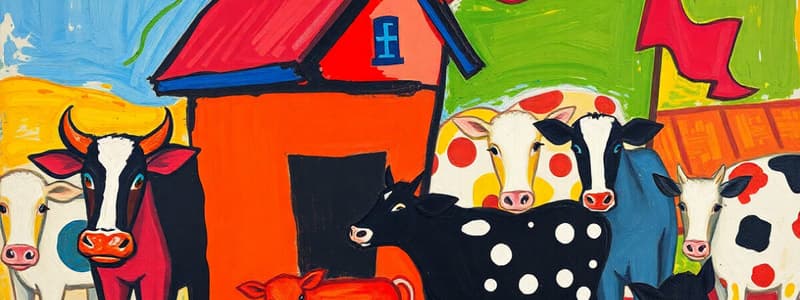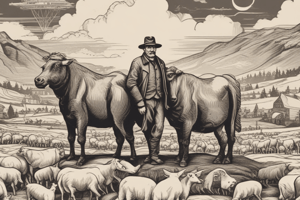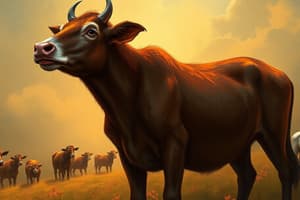Podcast
Questions and Answers
In Animal Farm, what does Old Major's dream of a world free from human oppression primarily symbolize?
In Animal Farm, what does Old Major's dream of a world free from human oppression primarily symbolize?
- The cyclical nature of power struggles between different species.
- The potential for a utopian society based on equality and freedom. (correct)
- The dangers of unchecked industrialization on agricultural societies.
- The inevitability of animal dominance over humans.
How does Napoleon's rise to power in Animal Farm reflect the events of the Russian Revolution?
How does Napoleon's rise to power in Animal Farm reflect the events of the Russian Revolution?
- It represents the successful implementation of socialist policies in the Soviet Union.
- It parallels the rise of Joseph Stalin through manipulation, propaganda, and force. (correct)
- It mirrors the peaceful transition of power from the Tsar to a democratic government.
- It symbolizes the collective leadership that emerged after the Tsar's abdication.
What is the significance of Squealer's role in Animal Farm?
What is the significance of Squealer's role in Animal Farm?
- He demonstrates how propaganda and manipulated language can control and deceive a population. (correct)
- He advocates for transparency and open communication within the farm community.
- He ensures the animals receive accurate information about the farm's progress.
- He embodies the importance of education and critical thinking among the working class.
Boxer's unwavering loyalty and dedication to Animal Farm, despite the deteriorating conditions, primarily symbolize what?
Boxer's unwavering loyalty and dedication to Animal Farm, despite the deteriorating conditions, primarily symbolize what?
The gradual alteration of the Seven Commandments in Animal Farm demonstrates what critical theme?
The gradual alteration of the Seven Commandments in Animal Farm demonstrates what critical theme?
How does the pigs' adoption of human habits and behaviors in the later part of Animal Farm contribute to the novel's central message?
How does the pigs' adoption of human habits and behaviors in the later part of Animal Farm contribute to the novel's central message?
The Battle of the Cowshed in Animal Farm, where the animals defend their farm against Mr. Jones and his men, symbolizes which historical event?
The Battle of the Cowshed in Animal Farm, where the animals defend their farm against Mr. Jones and his men, symbolizes which historical event?
The ending of Animal Farm, where the pigs and humans become indistinguishable, primarily suggests what about the nature of revolutions?
The ending of Animal Farm, where the pigs and humans become indistinguishable, primarily suggests what about the nature of revolutions?
What does the character of Benjamin, the cynical donkey, represent in Animal Farm?
What does the character of Benjamin, the cynical donkey, represent in Animal Farm?
What is the symbolic significance of the windmill in Animal Farm?
What is the symbolic significance of the windmill in Animal Farm?
How does the character of Moses, the raven who speaks of Sugarcandy Mountain, function within the allegory of Animal Farm?
How does the character of Moses, the raven who speaks of Sugarcandy Mountain, function within the allegory of Animal Farm?
Mr. Frederick's deceitful purchase of timber from Napoleon and subsequent attack on Animal Farm primarily symbolize what?
Mr. Frederick's deceitful purchase of timber from Napoleon and subsequent attack on Animal Farm primarily symbolize what?
The sheep's constant bleating of slogans like "Four legs good, two legs bad" demonstrates what aspect of totalitarian control?
The sheep's constant bleating of slogans like "Four legs good, two legs bad" demonstrates what aspect of totalitarian control?
In what way does Snowball's expulsion from Animal Farm and subsequent demonization reflect events in the Russian Revolution?
In what way does Snowball's expulsion from Animal Farm and subsequent demonization reflect events in the Russian Revolution?
The changing of the farm's name back to "Manor Farm" at the end of the novel symbolizes what?
The changing of the farm's name back to "Manor Farm" at the end of the novel symbolizes what?
How does the pigs' control over education and information contribute to their dominance on Animal Farm?
How does the pigs' control over education and information contribute to their dominance on Animal Farm?
Which of the following best describes the literary device most prominently used in Animal Farm to convey its message?
Which of the following best describes the literary device most prominently used in Animal Farm to convey its message?
What is the primary purpose of satire as used in Animal Farm?
What is the primary purpose of satire as used in Animal Farm?
How does the pigs' initial establishment of Animalism and the Seven Commandments contrast with their later actions?
How does the pigs' initial establishment of Animalism and the Seven Commandments contrast with their later actions?
The confessions and executions that take place on Animal Farm under Napoleon's rule are most likely symbolic of what?
The confessions and executions that take place on Animal Farm under Napoleon's rule are most likely symbolic of what?
Flashcards
Animal Farm
Animal Farm
An allegorical novella by George Orwell, published in 1945, representing the Russian Revolution and Stalinist era.
Old Major
Old Major
An aged pig who inspires the Rebellion with his vision of a socialist utopia.
Napoleon
Napoleon
A Berkshire boar who seizes control of the farm through manipulation and terror.
Snowball
Snowball
Signup and view all the flashcards
Squealer
Squealer
Signup and view all the flashcards
Boxer
Boxer
Signup and view all the flashcards
Clover
Clover
Signup and view all the flashcards
Benjamin
Benjamin
Signup and view all the flashcards
The Dogs
The Dogs
Signup and view all the flashcards
The Sheep
The Sheep
Signup and view all the flashcards
Mr. Jones
Mr. Jones
Signup and view all the flashcards
Animalism
Animalism
Signup and view all the flashcards
First Commandment
First Commandment
Signup and view all the flashcards
Symbolism of the Farm
Symbolism of the Farm
Signup and view all the flashcards
Symbolism of the Windmill
Symbolism of the Windmill
Signup and view all the flashcards
Allegory in Animal Farm
Allegory in Animal Farm
Signup and view all the flashcards
Satire
Satire
Signup and view all the flashcards
Foreshadowing
Foreshadowing
Signup and view all the flashcards
Anthropomorphism
Anthropomorphism
Signup and view all the flashcards
Mr. Pilkington
Mr. Pilkington
Signup and view all the flashcards
Study Notes
- An allegorical novella by George Orwell, published in 1945.
- Represents events of the Russian Revolution of 1917 and the Stalinist era of the Soviet Union.
- Uses animals on a farm to symbolize different social classes and political figures.
- Explores themes of totalitarianism, social inequality, and corruption of power.
Characters
- Old Major: An aged pig who inspires the Rebellion with his vision of a socialist utopia.
- Based on Karl Marx and Vladimir Lenin.
- His teachings form the basis of Animalism.
- Napoleon: A Berkshire boar who seizes control of the farm through manipulation and terror.
- Represents Joseph Stalin.
- Uses propaganda and violence to maintain his power.
- Snowball: A pig who advocates for modernization and improvement of the farm.
- Represents Leon Trotsky.
- Driven out by Napoleon and becomes a scapegoat.
- Squealer: A pig who serves as Napoleon's propagandist, distorting information and manipulating language.
- Embodies propaganda and the control of information in totalitarian regimes.
- Boxer: A loyal and hardworking cart-horse who believes in the ideals of the Rebellion.
- Represents the exploited working class.
- His motto is "I will work harder" and "Napoleon is always right".
- Clover: A gentle mare who suspects the pigs of corruption but is unable to articulate her doubts.
- Represents the more intelligent but powerless working class.
- Benjamin: A cynical donkey who remains skeptical of the revolution.
- Represents the intellectuals who are aware of the corruption but do little to resist.
- Moses: A raven who spreads stories of Sugarcandy Mountain, representing religion.
- Initially allowed by the pigs, then later returns when the pigs find him useful.
- The Dogs: Napoleon's personal bodyguards, used to enforce his rule through fear.
- Represent the secret police or military force of a totalitarian regime.
- The Sheep: Followers of Napoleon, they are easily manipulated and repeat slogans.
- Represent the blind followers of totalitarian regimes.
- Mr. Jones: The original owner of Manor Farm, representing Tsar Nicholas II.
- An irresponsible and neglectful farmer overthrown by the animals.
- Mr. Frederick: The owner of Pinchfield farm who tricks Napoleon and attacks Animal Farm.
- Represents Adolf Hitler and Nazi Germany.
- Mr. Pilkington: Owner of Foxwood farm, who is a shrewd and opportunistic neighbor.
- Represents the Allied powers (Britain and US).
Plot Summary
- Old Major inspires the animals of Manor Farm to rebel against Mr. Jones due to his maltreatment.
- After Old Major's death, the animals successfully revolt and establish Animal Farm.
- They create a set of principles called Animalism, summarized in the Seven Commandments.
- The pigs, Napoleon and Snowball, emerge as leaders, but they develop different visions for the farm.
- Napoleon uses his dogs to chase Snowball off the farm and assumes total control.
- Under Napoleon's rule, the farm gradually becomes a totalitarian state.
- The pigs begin to resemble humans, adopting their behaviors and vices.
- The Seven Commandments are altered to justify the pigs' actions.
- The animals are overworked and oppressed, while the pigs live in luxury.
- Boxer is sold to the glue factory when he is no longer useful.
- The pigs change the name of the farm back to Manor Farm, undoing the revolution.
- The story concludes with the pigs indistinguishable from the humans, symbolizing the complete corruption of the revolution's ideals.
Themes
- Totalitarianism: The novel critiques the dangers of centralized power and the suppression of individual freedom.
- Social Inequality: The pigs exploit the other animals, creating a class system that contradicts the revolution's original goals.
- Propaganda and Manipulation: Squealer's use of language and misinformation demonstrates how propaganda can control public opinion.
- Corruption of Ideals: The initial ideals of Animalism are distorted and used to justify the pigs' selfish actions.
- Naivety and Ignorance: The animals' lack of critical thinking and education makes them vulnerable to manipulation.
- Power and Control: The novel examines how power can corrupt and how those in power will do anything to maintain control.
Animalism
- A philosophy developed by the pigs, based on Old Major's teachings.
- Represents communism/socialism.
- Initially based on equality and freedom for all animals.
- The Seven Commandments are the core principles of Animalism.
- Becomes corrupted as the pigs gain power, serving to justify their actions.
The Seven Commandments (and their alteration)
- Whatever goes upon two legs is an enemy: Later changed to "Four legs good, two legs better".
- Whatever goes upon four legs, or has wings, is a friend.
- No animal shall wear clothes.
- No animal shall sleep in a bed: Later changed to "No animal shall sleep in a bed with sheets".
- No animal shall drink alcohol: Later changed to "No animal shall drink alcohol to excess".
- No animal shall kill any other animal: Later changed to "No animal shall kill any other animal without cause".
- All animals are equal: Later changed to "All animals are equal, but some animals are more equal than others".
Symbolism
- The Farm itself symbolizes Russia/Soviet Union.
- The Windmill symbolizes Stalin's Five-Year Plans.
- The Battle of the Cowshed symbolizes the Russian Civil War.
- The confessions and executions symbolize the Great Purge.
- The card game at the end symbolizes the Tehran Conference.
Literary Devices
- Allegory: The entire novella is an extended allegory for the Russian Revolution.
- Satire: Orwell uses satire to expose the hypocrisy and absurdity of totalitarian regimes.
- Irony: There is a strong sense of irony throughout the novel, as the animals' revolution leads to an even worse state of oppression.
- Foreshadowing: Hints of the pigs' future corruption are present early in the story.
- Anthropomorphism: Animals are given human characteristics, thoughts, and emotions.
Studying That Suits You
Use AI to generate personalized quizzes and flashcards to suit your learning preferences.




